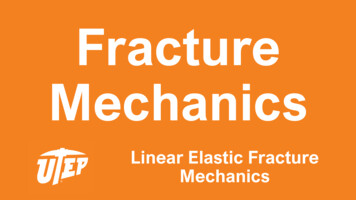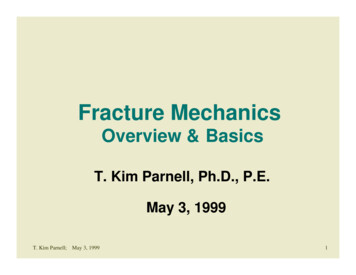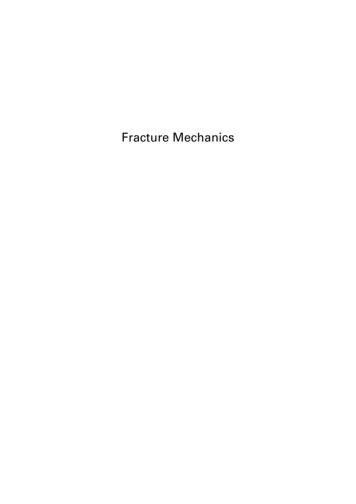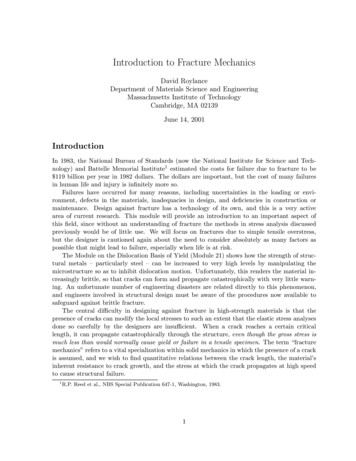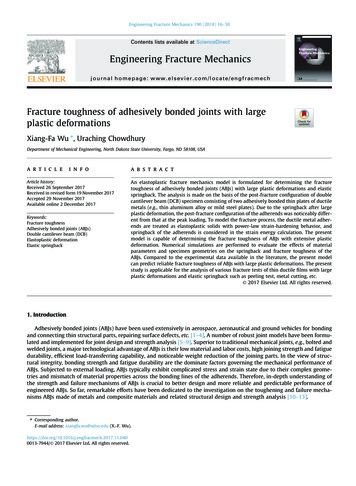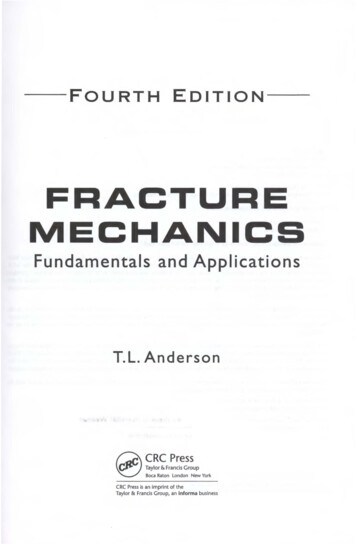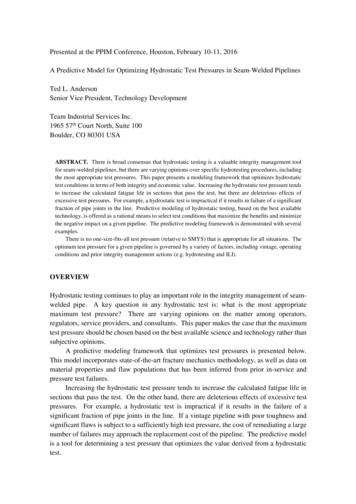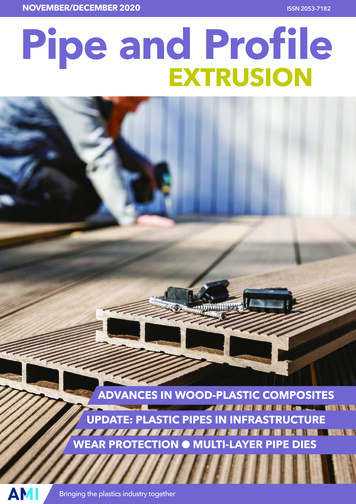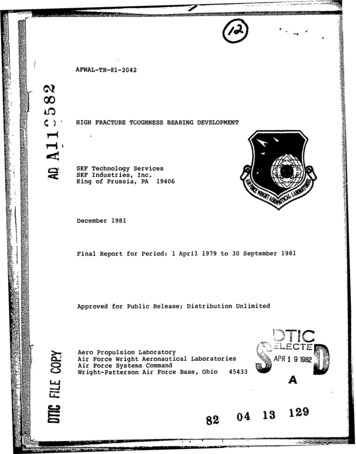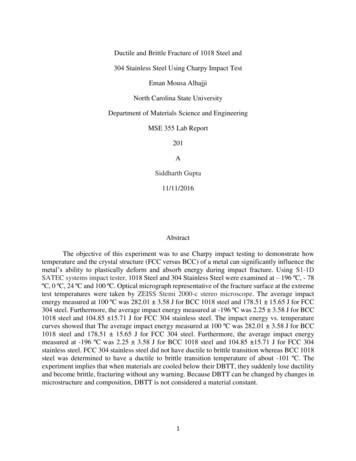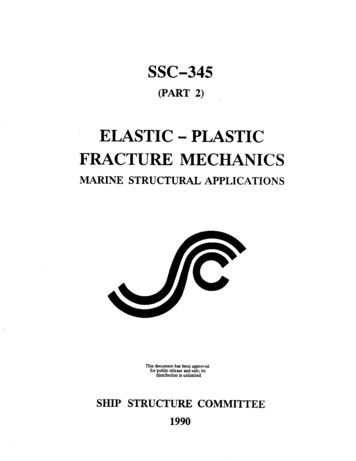
Transcription
SSC-345(PART 2)ELASTIC - PLASTICFRACTURE MECHANICSMARINE STRUCTURAL APPLICATIONSThisdocumenthas keen approvedfor publicreleweandsale;itsdishibutionis unlimitedSHIP STRUCTURE COMMITTEE1990
SHI P STRUCTURFCOMMIT#FThe SHIP STRUCTURE COMMillEEis constituted to prosecute a research program to improve the hullstructures of ships and other marine structures by an extension of knowledge pertaining to design,materials, and methods of construction.RADM J. D. Sips, USCG, (Chairman)Chief, Office of Marine Safety, Securityand Erwironmental ProtectionU.S. Coast GuardMr. H. T. HailerA?.sociate Administrator for Shipbuilding and Ship OperationsMaritime AdministrationMr. Alexander MalakhoffDirector, Structural IntegritySubgroup (SEA 55Y)Naval Sea Systems CommandMr. 11’romas W. AllenEngineering Officer (N7)Military Sealift CommandDr. Donald LiuSenior Vice PresidentAmerican Bureau of ShippingCDR Michael K. Parmelee, USCG,Secretay, Ship Structure CommitteeU. S. Coast GuardMr. William J. SiekierkaSE455Y3Naval Sea Systems CommandMr. Greg D. WomlsSm 55Y3Naval Sea Systems CommandTSHIPSTRUCURFSLJBCOMMlnFFThe SHIP STRUCTURE SUBCOMMllTEEacts for the Ship Structure Committee on technical matters byproviding technical coordination for determinating the goals and objectives of the program and byevaluating and interpreting the results in terms of structural design, construction, and operation.AMERICANBUREAU OF SHIPPINGNAVAL SEA SYSTEMSCOMMANDMr,Mr.Mr.Mr.Stephen G, Arntson (Chairman)John F. CordonWilliam HarrzalekPhilip G. RynnMr.Mr.Mr.Mr.!MIlITARYSEAIJT COMMANDY.s.COASTGUARDMr, Albert J. AttermeyerMr. Michael W. ToumaMr. Jeffery E. BeachMARITIMEMr.Mr.Mr.Dr.Robefi A SielskiCharles L. NullW, Thomas PackardAllen H. EngleCAPT T. E. ThompsonCAPT Donald S. JensenCDR Mark E. NellADMINISTRATIONFrederick SeiboldNorman 0, HammerChao H. LinWalter M. MacleanSHIP STRUCTURFU.S.COASTSUBCOMMITTFFI WISON MF GUAR ACAJ7FMYLT Bruce MustainMr. Alexander B. StavovyU. S. MERCHANTMARINE ACADEMYNATIONAL ACAD E M Y QF SCIENCES-Dr. C. B. KimsU, S. NAVAL ACADEMYMr. Stanley G. StiansenDr. Ramswar BhattachayyaSOCIETYMRINEOF NAVAL ARCHITE CTS ANDENGINEERS -Dr. William SandbergDr. W. R. PorterAMERICA N IRON AND STEEL INSTITUTEWELDINGRESEARCHCOUNCILMr. Alexander D. IMlsonDr. Martin Prager
MemberAgencies:UnitedStates Coast GuatdSea Systems CommandNavalMatitime AdministrationAmerkan Bureau of Shi dress Correspndencs to:Secretay, Ship StruotureCommitteeU.S.tiast Guard(G-MT )2100 Second Street S.W.Washington,D.C. 205934001PH: (202)267-W03FAX (202)267-0025An Interagency Advisofy CommitteeDedicated to the Improvementof Marine StmturesDecember 17, 1990SSC-345SR-1321ELASTIC-PLASTIC FW4CTTJRE MECHANICSMARINE STRUCTUWL APPLICATIONSThis is the second part of a two part report. The first reviewedthe history and state-of-the-art of elastic-plasticfracturemechanics.This volume presents the results of an analytical andexperimental study of fracture in the ductile-brittle transitionregion in ship hull steels. It is important that we increase ourknowlededge in this area of fundamental material properties.Afracture mechanics based approach to design and analysis canprovide a more qualitative assessment of the integrity of marinestructures.r ?5i-Rear Admiral, U.S. Coast GuardChairman, Ship Structure Committee
Technical Report Documentation ’sCotologNo.SSC-345 - Part 24.Titleand5.SubtitleReportDoteApril 1990Elastic-Plastic Fracture Mechanics Marine Structural Applications7.6.Per ortT. L. ssTexas A & M Research Foundation3578P. O. BOXCollegeStation,TX 7784310.WorkUnit13.Typeof‘&’ fi ffpY N. md .dclr,.U.S. Coast Guard2100 Second Street, SWWashington, DC 2059315.No.Author/s)SupplementaryNo.(T RAIS)ReportondPtriodCoveredFinal ReportNotesSponsored by the Ship Structure Committee and its member agencies.16.AbstructThis document contains the results of experimental and analyticalstudies of fracture in the ductile-brittle transition zone for twoship steels, EH36 and HSLA 80. Tensile, Charpy and fracturetoughness test results using different strain rates are presented.Fracture toughness was quantified by the J integral and the crack tipopening displacement (CTOD). Elastic-plastic finite element analysiswas combined with a local failure criterion to derive size limits forJ and CTOD testing in the transition regions. Relationships betweenJ and CTOD were explored both experimentally and analytically. Atheoretical Charpy-fracture toughness relationship was used topredict CTOD transition curves for the steels.Charpy and CTODtransition temperatures were compared for a number of 1 Technical Information ServiceVA 22161 orarine Tech. Information Facilityational Maritime Research Centerw10024-1699Words18.Fracture MechanicsElastic-Plastic DeformationFracture ToughnessTransition ssified96Form DOT F1700.7(8-72)Reproductionof completedipogeouthorized22.Price
METFUCCOWERSIONfACTORS ppro imt!rCanwrsiorfsto MatficMaa urss,SfmbdAppmrimdaCanwarsimrshomMaSrmhdWhim ga KnowMdt@h 4111IrmtmsCent mutersmtwsk,lan amnl,*cmcmIn\mmkmkmAREAAREA6.smqum* hch02ZqmfaclSqlJarmVznrs9qu4r.2.00.4mih4.X- mMASSCmllrrmwsImt*ramawsCAm’d241u2M hika-rduskm2WW*0,090.8qwmZqumhararasbh-MASS waight)[waight)mOuncmlbpcuds0.45ki hgrmsshmt Ims{2MHl lb)0,9tmn.swP.C ##km’2a9kg10.0369kggrin-mkilqrms1ICmmm ilom2.21.1kg)VOWMEtspIG4-S6mapt-el*umtl*15ilfluid ouncancupspimsqualm!gOltms3002cmqlga IIisvda0.240.470.953,8cubfc tnelcubrc yardsmillil,lwsmi llililor ml#li#itetsmtmlmlti mmIitwsIIJIltwsIitetaCub,c melarscubic il.rsml0.032.*1.040.25351.3Iit.mcubic nmtnrscubic nmwsLm’[artact 9/6 IllwnCelsius“cMM 32Jt-wraaweFahrnnhaiiWmlwat”ra5/9 lallats“bl,act mg32 ‘F-40,,I01120il,,40z?12,,
EXECUTIVE SUMMARYThis researchprogram consistedof experimentaland analytical studies of fracture inthe ductile-brittletransition region of ship steels. Two materials were tested: a 25.4mm thick plate of ASTM A 131 EH36 steel and a 31.8 mm plate of HSLA 80 steel.TensiIe, Charpy, and fracture toughnesstemperatures.tests were performedover a range ofThe tensile tests were conducted at three strain rates: 0.0033, 5.1 and280 s-1. Most of the Charpy and fracture toughness testing was concentrated in thetransition region of each steel. Fracture toughness was quantified by the J integraland the crack tip opening displacement (CTOD).Elastic-plasticfinite element analysis was combinedwith a local failurecriterion to derive size limits for J and CTOD testing in the transition region.Theselimits are eight times more strict than the size requirements for JIC testing but areless severe than the requirements for a valid KIc test.When fracture toughnessdata do not meet the required specimen size, the data can be corrected for constraintIoss.This correction not only removes the size dependence of fracture toughnessbut ako greatly reduces the scatter. Conceivably, this approach can also be applied tostructures, although the computational requirements would be severe.Relationshipsexperimentally.between J and CTOD were explored both analyticallyBoth parametersandare essentially equivalent measures of elastic-plastic toughness.A theoreticalCharpy-fracturetoughness relationshipwas used to predictCTOD transition curves for the A 131 EH36 and HSLA 80 steels.agreement between theory and experimentwas reasonablyAlthough thegood in both cases,further refinement and validation is needed before this approach can be used inpractical situations.A parametric study showed that the predicted CTOD transitioncurve is highly sensitive to the dynamic flow properties.Charpy and CTOD transition temperatures were compared for a number ofsteek.There appears to be no unique relationship betw n these two temperatures.Material toughness criteria based on Charpy energy should be used with extremecaution.iii
TABLE OF CONTENTS1- INTRODUCTION .11.1 THE LI.TEMTUREREVIEW .**.**.2 1.1.1 FractureToughnessTesting .21.1.2 Application to Structures .41.2 EXPERIMENT AL AND ANAL CALSTUDIES .62. EXPERIMENTAL CHAlG4CTERIZATION OF SHIP STEELS . 72.1 TEST MA LS.0.72.2 EXPERIMENTAL PROCEDURE .72.2.1 Tensile Tests . 72.2.2 Charpy Impact Tests . 82.2.3 Fracture Toughness Tests . 82.3 RESULTS . 92.3.1 Tensile Data . 92.3.2 Charpy Data . 102.3.3 Fracture Toughness Data . 113. SPECIMEN SIZE EFFECTS IN THE TRANSITION REGION .313.1 SINGLE PAR4METERFRACTURE MECHANICS .313.1:1 Existing Standards . 313.1.2 Size Criteria for the Transition Region .333.2 ANALYSIS PROCEDURES . 333.2.1 Relationship to Previous Work . 333.2.2 Finite Element Analysis . 343.2.3 Cleavage Fracture Criterion . 353.3 RESULTS . 373.3.1 Small Scale Yielding . 37iv
3.3.2 SENB Specimens .383.3.3 Effect of Speamen Dimensions on Jc . 383.3.4 Effect of Thickness .403.3.5 Comparison with Experimental Data .413.4 SPECIMEN SIZE REQUIREMENTS .423.5 CONSTRAINT EFFECTS IN THE TWO SHIP STEELS .433.6 STRUCTURAL APPLICATIONS .434. COMPARISON BETWEEN FlU4CT’IJRE TESTS .614.1 J-CTOD RELATIONSHIPS .6l4.1.1 Analytical Comparisons .614.1.2 Experimental Comparisons .624.2 CVN-FlU4CTURE TOUGHNESS RELATIONSHIPS .634.2.1 Theoretical Model .634.2.2 Comparison With Experiment .664.4.2 Parametric Study of Theoretical Model .664.3 STRUC LSIGNIFICANCE OF CVN REQUIREMENTS .675. SUMMARY AND CONCLUSIONS .806. REFERENCES .82/’
1. INTRODUCTIONThe Ship Structures Committee (SSC) has recognized the importanceof fracturemechanics technology to the design and fabrication of marine structures.Existingfracture control procedures rely heavily on arbitrary Charpy impact requirements,but a fracture mechanics based approach would allow more quantitativeassess-ments of structural integrity.Many welded steel structures, such as ships, operate in or near the ductile-brittIe transition region, where the failure mechanism is unstable cleavage.Althoughcleavage is often referred to as brittle fracture, cleavage in the transition region canbe preceded by significant plastic deformation and stable tearing. Consequently, fracture in the transition region is typically elastic-plastic in nature; linear elastic fracture mechanics (LEFM) is usually invalid, and material toughness cannot be quantified by K1c.Most of the research in elastic-plasticfracture mechanicsUnited States has focused on the upper shelf of toughness.conductedin theThis work has beensponsored primarily by the nuclear power industry, which is concerned with servicetemperatures well in excess of ambient temperature.Fracture mechanics research inthe United Kingdom, however, has been motivated largely by the construction ofoffshore platforms in the North Sea, wh
fracture mechanics based approach to design and analysis can provide a more qualitative assessment of the integrity of marine structures. r ?5i-Rear Admiral, U.S. Coast Guard Chairman, Ship Structure Committee. Technical Report Documentation Page 1. Report No. 2. Government Accession No. SSC-345 - Part 2 4. Title and Subtitle Elastic-Plastic Fracture Mechanics - Marine Structural

